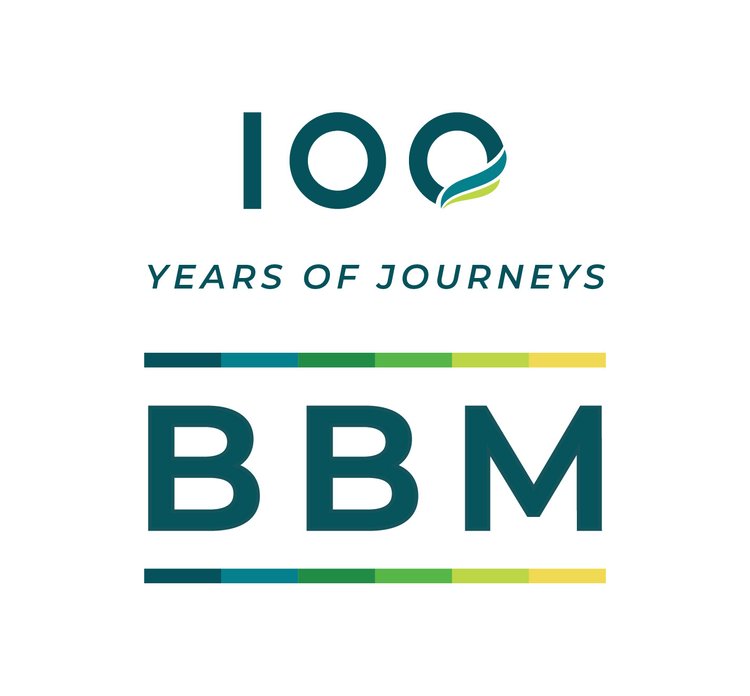May 1 - 31, 2025: Issue 642
Big Brother Movement Celebrates 1925 to 2025 Centenary: Now Sends Australians Out into the World - Scholarships Now open for All Young Australians
Celebrating Courage, Care and Connection.
For a century, the Big Brother Movement (BBM) has been a catalyst for change and opportunity, opening doors for young people to explore the world and make their mark.
It began as Australia’s most successful migration program for young men moving from the UK to Australia, the Big Brother Movement.
Today, built on this legacy, BBM continues to empower young people to venture overseas for work experience through their Global Footprints Scholarships program.
So instead of bringing young people to Australia to access all the opportunities here, they are providing a chance for young Australians to follow their vocational dreams overseas.
A National Monument to Migration Ceremony took place yesterday, Saturday 10 May 2025. This moving ceremony included the unveiling of names on The Welcome Wall, Australia’s National Monument to Migration, highlighting migrant stories and the Australian National Maritime Museum’s role in shaping Australia’s identity.
Their BIG Centenary Grand Celebration at the Maritime Museum will take place on Tuesday 12 August 2025 at the Australian National Maritime Museum and they are currently reaching out and asking all former 'Little Brothers' to contact them and get involved.
Join them as they continue to champion the remarkable journeys of young people in this world.
- 100 years of opening up the world to young people
- The legacy of Australia's most successful historic migration program, the Big Brother Movement
- 40 years of scholarships for vocational work experience around the world
- Celebrating stories of courage, care, and connection
Join us in championing the remarkable journeys of young people growing a better world.
This week a look into their Global Footprints Scholarship, now open for applications and closing June 1, some history of the movement, and an insight from a former Mona Vale resident and Manly Daily gentleman who was a 1950 'Little Brother'.
First a few insights into their Global Footprints Scholarship opportunity for young men and women aged 18 to 24.
What is a Global Footprints Scholarship?
A Global Footprints Scholarship is a self-directed career development opportunity for young Australians in agriculture, trades and horticulture. Successful applicants receive an AUD $9,000 grant to travel overseas for industry experience, professional development workshops, networking opportunities and mentoring.
Scholarships are awarded once a year.
Who can apply?
To be eligible for a Global Footprints Scholarship you must be an Australian citizen or permanent resident and be between 18-25 years old. Check their “Who can apply?” page for full details. If your application is shortlisted you will need to provide evidence for the above.
Applications open every year on 1 May and close 1 June. Shortlisted applicants will be notified by September.
Will you assist me in finding a work placement?
The Global Footprints Scholarship is a self-directed career development opportunity. You are expected to have a good idea of where you want to go and why, including an understanding of who the industry trailblazers in your field are and where they are located. Networking to find your placement is the first critical learning opportunity of your scholarship experience. We will give you advice on how to approach them, and put you in touch with past scholars who can help.
Find out more in the FAQ's: www.globalfootprints.org.au/faq
About the Big Brother Movement: a chance to reconnect in 2025
The Big Brother Movement (BBM) was one of Australia’s most significant migration schemes, offering young British men—known as ‘Little Brothers’—the opportunity to start a new life in Australia. Founded in 1925, the scheme ran until 1982, by which time close to 12,000 lads of ‘good character’ who were aged between 16 and 21 had travelled alone from the UK to Australian shores to be assigned a Big Brother guardian and receive training and jobs in rural and trade industries.
Now, 100 years on, BBM is looking to reconnect with those who were part of this unique migration experience, a task made difficult as the movement originally discouraged the Little Brothers to keep in touch and to become part of Australian society. In addition, some of the records of those who migrated with the scheme were lost many years ago.
Steven Bennett, OAM was 16 years old when he left for Australia on 31 July 1970, and admits he thought several times about backing out. “I told myself it was time to start doing what was going to become commonplace: ‘grit your teeth, blast through and don’t stop.’ After three rugged years of farm life, Steven’s family migrated from England, and they moved to Sydney. After jobs in marine pharmacology and medical research he co-founded an electronics company with his brother and became a trail blazer in employing people with disability. It is through this endeavour that Steven received an Order of Australia. He admits there have been many challenges but says “I remain grateful for all the opportunities that have shaped me into the person I am today.”
“We know that many of our ‘Little Brothers’ have lost touch with BBM and with each other,” says Suellen McCaffrey, CEO of BBM. “As we celebrate 100 years, we want to honour their stories, the impact this program had on their lives and the contributions our former Little Brothers made to shaping modern Australia.”
BBM is inviting all former Little Brothers, their families, and those with a connection to the program to come forward and share their stories. The organisation is collecting testimonials and photographs to preserve this important part of Australian migration history. A recent study estimated that there are more than 97,000 direct descendants of Little Brothers.
“This centenary, celebrating 100 years of journeys, is not just about looking back—it’s about reconnecting and celebrating the legacy of those who took a leap of faith and built new lives here,” Suellen McCaffrey added.
Today, built on this legacy, BBM continues to empower young people to venture overseas for work experience through the Global Footprints scholarship program. When the migration scheme ended in 1983, its assets, including a training farm formed the foundation of a new program for young people from Australia to make the life-changing journey overseas, opening doors for young people to explore the world and make their mark.
Reunion Event
“Our Centenary Year launched on the 3rd of March at the Training Farm in Sydney, where many Little Brothers started their life in Australia. We also have a celebration in August at the Australian National Maritime Museum in Sydney, as well as reunions across Australia. We look forward to meeting any former Little Brothers and their families at these events and hear their stories.”
‘’A century ago, BBM was founded with a bold vision— to give young people a chance to build a new life, to grow, and to contribute to the communities they became part of. Thousands of young men left the UK full of hope and courage, seeking adventure, opportunity, and a fresh start in Australia.
When the migration program ended in 1983, BBM’s assets, including the training farm, where many of you trained, were sold and invested. Those funds have since provided more than 1,100 young Australians with scholarships, allowing them to travel overseas for work experience and, most recently, to learn more about sustainability initiatives that can help us in Australia prepare for future challenges. ‘’-
For a century, we have been a catalyst for change and opportunity, opening doors for young people to explore the world and make their mark.
It began as Australia’s most successful migration program for young men moving from the UK to Australia, the Big Brother Movement. Today, built on this legacy, we continue to empower young people to venture overseas for work experience through our Global Footprints scholarship program.
We celebrate the stories of courage, care and connection of our former Little Brothers, and pass on their legacy to our young scholars as they explore the globe and become practical, impactful leaders who grow a better, more sustainable world.
Join us as we continue to champion the remarkable journeys of young people in this world.
The History of the Big Brother Movement
In 1925, Australia sought strong, willing young men eager for adventure and a new life. The Big Brother Movement (BBM) was founded to meet this need, and over 200 "Little Brothers" sailed from England on the Jervis Bay, arriving in Australia on 14 December 1925.
Early Years (1925-1947)
Until 1947, these young men were trained for farm work at government-run training farms like Scheyville, NSW. The migration scheme was interrupted first in 1931 due to the Great Depression and again in 1939 with the outbreak of World War II, despite five ships making the journey that year.
Post-War Resumption and Growth (1947-1982)
Migration resumed in 1947, with BBM sponsoring around twelve thousand lads to settle in Australia until 1982. In April 1947, the Movement purchased a 600-acre property known as “Karmsley Hills” at Bossley Park near Liverpool, NSW, for £15,000. This farm was dedicated as a memorial to the Little Brothers who lost their lives in the war. Between 1947 and 1971, nearly 4,000 British lads passed through this establishment.
Shifts and Evolution
By the late 1950s, more lads were arriving for city work rather than farming. The average age of the arrivals up to the 1960s was 16, but later arrivals tended to be up to 20 years old. In 1983, the sponsorship scheme ended due to changing migration rules, leading to the sale of the farm and the reinvestment of the funds.
These funds enabled the organisation to evolve into BBM Youth Support, continuing to support young talent through various initiatives.
Continuing Legacy
Today, hundreds of Little Brothers remain in contact with BBM. The organisation maintains an archive and historical records of the Little Brothers who arrived in Australia from 1925 to 1982. Often, this archive serves as the only official record of their journey to a new land of opportunity.
If you are a Little Brother, a relative of a Little Brother, or simply interested in the Big Brother Movement, we’d love to hear from you. Please call or email us at bigbrothermovement@bbm.asn.au.
Centenary Grand Celebration at the Maritime Museum
- Tuesday 12 August 2025: 11:00 am to 2:00 pm
- Australian National Maritime Museum
On 12 August 12th, join us at the Australian National Maritime Museum in Darling Harbour, Sydney, for BBM’s Centenary Grand Celebration—commemorating 100 years of history and community.
RSVP to: www.bbmaustralia.org.au/centenary-events/centenary-celebration-at-the-maritime-museum
About Us
For a century, BBM has been a catalyst for change and opportunity, opening doors for young people to explore the world and make their mark.
Originally established as Australia's most successful migration program for young men from the UK, known as the Big Brother Movement, BBM has evolved significantly over the years.
Today, we proudly continue this legacy through our Global Footprints Scholarship program, empowering young people to gain invaluable work experience overseas.
By celebrating the courage, care, and connection of our former Little Brothers, we honour their legacy and inspire our young scholars as they embark on global journeys, becoming practical and impactful leaders in agriculture, horticulture and trades.
Our scholarship program is dedicated to supporting young people in vocational careers, helping them become holistic leaders aligned with the United Nations Sustainable Development Goals. We achieve this by providing scholarships for global work experience, networking and development opportunities.
At BBM, we believe that our talented young people are the future of Australia.
We are committed to offering them opportunities to grow and learn in a global context.
Since awarding our first scholarships in 1983, we have sent over 1,100 young Australians overseas to pursue their professional goals. Our alumni have brought back innovation and international networks to Australia, excelled as industry leaders and educators, and continue to inspire those who follow in their footsteps.
Visit: /www.bbmaustralia.org.au
Our area has several connections to the Big Brother Movement, especially through those who came and stayed and enriched Australia by doing so. One example is:
OBITUARY
MR. PHILLIP LAMBERT-SMITH
Residents of Bourke and District, particularly the Byrock area, were saddened by the news that Mr Phillip Lambert-Smith had passed away.
A grazier of "Knightvale" Station, Byrock, the late Mr. Lambert-Smith was aged 62 years at the time of his death.
Phil had been ill for some time and was a patient in the District Hospital at the time of his death, which occurred on 25th December. He is survived by a sorrowing wife, Doreen, and one daughter, Judith (Mrs. B. Prince, Holbrook) and two grandsons. He is also survived by two sisters, Mrs. George Wells and Mrs. Raithley, both of whom reside at Reading in England.
The deceased was English born, a son of Percy Lambert-Smith, a surgeon dentist of Bristol. He came to Australia in 1925, being, in fact, the first English boy to enrol under the Big Brother Movement.
On arrival in Australia he went to the State Government Experimental Farm at Glen Innes. In 1937 he married Doreen O’Sullivan, at Maroubra. He was then a freelance journalist in the Sydney area residing at Avalon Beach.
In 1949 the family moved to "Knightvale," a grazing property in the Byrock district, which the deceased purchased in that year. They have resided at "Knightvale" ever since.
A funeral service was conducted at the Holy Innocents Church; Bourke, preceeding the burial Which was in the Church of England section of the Bourke cemetery.
Members of the Masonic fraternity conducted a Lodge of Sorrow at the Masonic Temple Bourke prior to the funeral.
Deepest sympathy is extended to relatives of the deceased. OBITUARY (1969, January 17). The Western Herald (Bourke, NSW : 1887 - 1893; 1895 - 1903; 1906 - 1914; 1916 -1980), p. 10. Retrieved from http://nla.gov.au/nla.news-article104126864
Another is a gentleman who some may remember from his days living at Mona Vale or his work for the Manly Daily.
Ian Anderson shares his story:
Ian Anderson
Little Brothers Story
Ship name: Ormonde
Arrival date: 14/08/1950
Almost 75 years ago, 25 Little Brothers and I left Tilbury Dock in London on 29 June 1950 on the RMS Ormonde. We were on our way towards a new life in Australia. I was 16 and had lived all my life in the poorer areas of Glasgow. We had to gain our sea-legs quickly on our 12 berth cabin on E deck two metres above the water’s plimsoll line. with no air con, no stabilisers and the single porthole welded shut.
Six weeks later, we docked at No. 2 Circular Quay Sydney (where the Opera House now stands) early in the morning of 14 August. Unbeknownst to me at the time, my future wife Jeanette was watching the Ormonde at berth, as she waited to disembark from her ferry which had crossed Sydney Harbour from Cremorne, taking her and all the other passengers to the city to work.
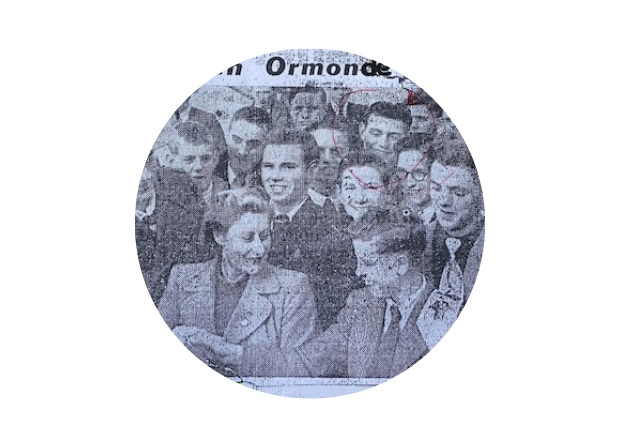
Onboard the Ormonde, we ate breakfast, gathered our few possessions, sped through Customers inspections and boarded a bus to go to the BBM Memorial Farm near the then small village of Fairfield, about 40 km south-west of Sydney Harbour. After some basic training by Farm Manager Bill Waite, most of the Little Brothers, including me, were assigned to work on various stations in NSW.
I was assigned to a farm near West Lynne about 15 km south of Jindabyne. The property was owned by an elderly gentleman Jack Kidman, a distant relative of “Cattle King” Sid Kidman. At the Kidman property I mustered cattle and sheep, once I was a competent horse rider and had mastered the art of cracking the stock-whip without gaining a tiger snake wrapping itself around the whip! I spent a fair bit of time killing the rabbits that then plagued Australia, and built and mended rabbit-proof fences.
Grandfather Jack’s grandson, Jack Junior would inherit the farm. Unlike his kindly grandfather, Jack Jr. was a mean spirited, sly person. Neighbouring station hands warned me to be on guard when he was around. They proved right – after a year I quit to get away from the grandson’s aggressive behaviour and returned to BBM in Sydney where they arranged for me to work on a mixed crop farm near Finley in the Riverina District. This was an unloved property, where I slept in my half of a corrugated iron tool shed. They “forgot” to pay me so I left after 4 months.
My next job was on the Snowy Mountains Scheme at Guthega; 10 hour shifts working underground in teams of 20 men. Good pay of $30 per week plus free food, room, transport to Cooma. It was dirty work jack hammering for 4 hours a day. I graduated to become a rock face diamond drill operator and a trainee “powder monkey”. Unfortunately both these work locations were a haven for violent drunken behaviour, with many traumatised refugees from WWII. You never asked anyone’s name or their background.
Back in Sydney I had a string of short-term, white collar jobs, plus I jack hammered the foundations for the Kent Street fire station on the approach to the Harbour Bridge, now a multi-story apartment block. I ended up at WD&HO Wills, responsible for Duty Free sales to the diplomatic corp in Sydney and Canberra. I was piped on-board a few RAN ships as I brought precious cargo with me ... cigarettes! Moving from Wills I built a career at John Fairfax newspapers for 13 years, where I became the Sales Manager for the Sun Herald newspaper, which then printed 750,000 copies every Sunday – the highest sales in Australia.
I joined the Manly Daily group owned by the Packer family, and for eight years was the Group Advertising Manager for Sydney north-side and Central Coast. After that I became a publisher myself, publishing local newspapers for various shopping centres in Sydney. My last job was at Shennen Publishers for 12 years, looking after the advertising and circulation of their bus and truck trade publications. I retired at 73.
During this time I was a frequent visitor to BBM when Eddy Steel was located in Hunter St. Unfortunately we lost contact with Eddy when he moved to Tweed Heads.
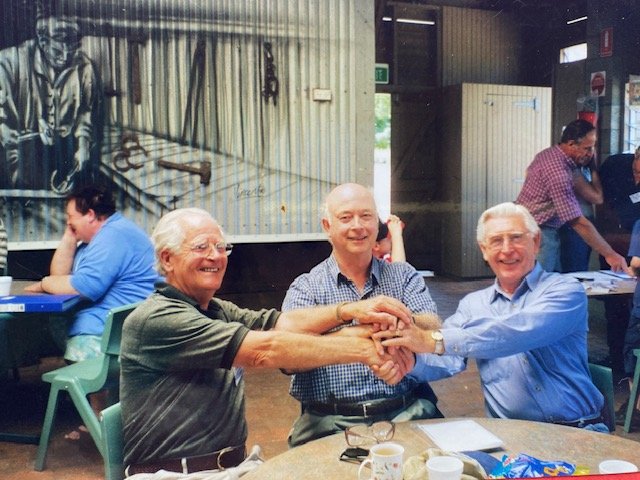
Jeanette and I met at a dance hall in Mosman. She was chaperoned by her older sister and cousins. We married when Jeanette was 20 and I was 21. Last year in April 2024 we celebrated our 70th wedding anniversary, receiving congratulations from King Charles, the Prime Minister, governors and MPs. Jeanette was a 5th generation Australian, with her people moving to country NSW from Cornwall in 1820. We had two daughters – Fiona and Louise, and have three grown-up grandchildren – Caitlin, Alexander (Sandy) and Ella. I was 56 when I discovered who my birth mother was. It turns out that my “aunt” Rachel was really my mother. Rachel wrote to me disclosing this sensitive information after Jeanette and I visited her back in Glasgow.
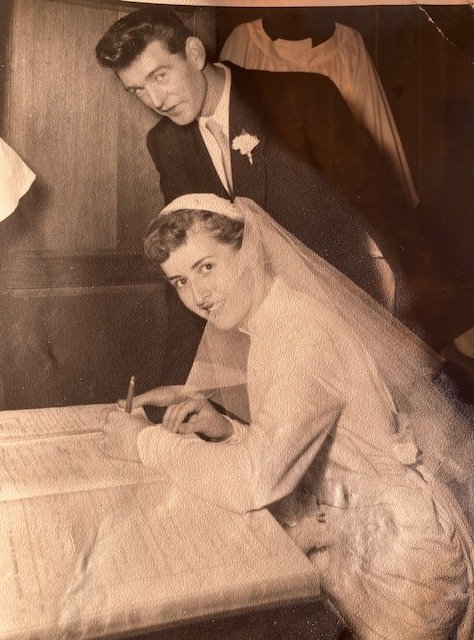
Jeanette and I raised our family in homes that we worked hard to renovate in Cremorne, Balgowlah Heights, Mosman and Mona Vale. When our grandchildren were young Jeanette played a big part in looking after them, ensuring that while their parents worked full time, the children received the love and attention that only a grandmother can bring.
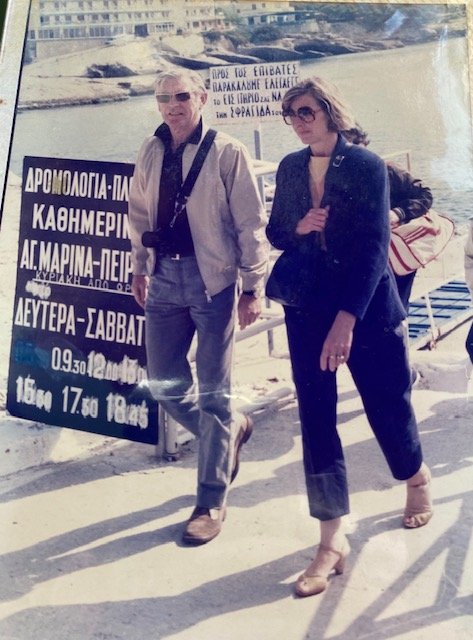
Jeanette and I travelled widely in Egypt, Denmark, Paris, Greece, Malaysia, Singapore, Thailand, Fiji, Western Samoa, England, Scotland and Cornwall. Back home we covered most of Australia, with the exception of the Kimberleys where our planned trip did not eventuate. Our travelling days came to an end because Jeanette’s condition of Alzheimer’s deteriorated greatly.
We had moved to Brisbane in 2019 to live next door to our elder daughter Fiona and her family, where Fiona and I shared looking after Jeanette. I did the lion’s share as Fiona still works full time. However it became too much for me to keep Jeanette safe and in 2022 we moved Jeanette to a nursing home that was exactly 400 steps from my home. She had a room overlooking Bramble Bay. I visited her every single afternoon until the day she died on 17 September 2024. I miss her greatly and know we will meet again one day.
My wife strongly encouraged me to maintain contact with BBM, and she would be pleased I have laid down a bit of my life-story today. I am eternally grateful for BBM for bringing a Glasgow lad to Sydney, where I have lived a very fortunate life.
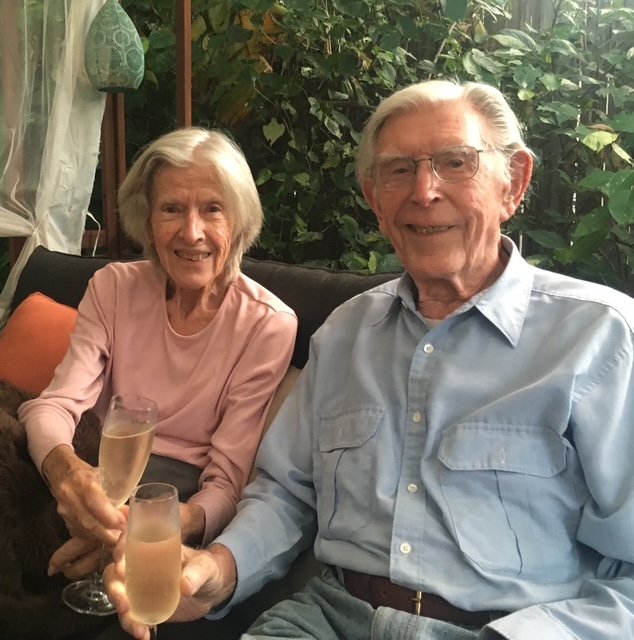
Calling all Former Little Brothers
Are you a former little brother? Perhaps you are researching your family history and it led you to here? Reach out to us with any questions you may have. We would love to hear from you!
Email: info@bbm.asn.au
Phone: +612 9233 4005
Write to: World Square, Level 45 , 680 George St, Sydney. NSW 2000.
